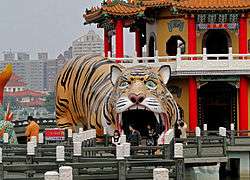Tiger in Chinese culture
Throughout Chinese history, the tiger has incited a sense of both awe and admiration: its prowess, its ferocity, its beauty, and the harmony of the opposites. The tiger is full of life and embodies the spirit and drive to achieve and make progress.

The tiger has been common in the southern and northeastern China and is revered by the Chinese as a creature with many symbolic attributes. Each direction of the compass is traditionally believed to be ruled by a mythical creature; the White Tiger is the ruler of the West. The tiger is also associated with autumn, when it comes down from the mountains into villages, and is personified by the constellation Orion, which is prominent in autumn. In Chinese astrology, the star Alpha of the Great Bear constellation gave birth to the first tiger. The tiger represents the masculine principle in nature and is king of all the animals, as shown by the four stripes on his forehead, which form the character Wang (王), or King.[1] The tiger is regarded as one of the four super-intelligent creatures, along with the dragon, phoenix and tortoise; for centuries, the four have been a major design motif in Chinese art.
In southern China, on the tiger's birthday, on the second moon in the lunar calendar, fixed in the Western calendar as March 6, women worship the White Tiger. They place paper images of the tiger in their homes to keep away rats and snakes and prevent quarrels. On this date, effigies of the tiger are also put in front of temple buildings for people to make offerings. The God of Wealth, the deified Marshal Chao Gongming (Chao Kungming), is depicted riding a black tiger and holding a silver ingot. The Chinese call an able general a "tiger general" and a brave soldier, a "tiger warrior".
In Chinese folk tales, tigers kill evil men and protect good men. Tiger charms are used to keep away disease and evil, and babies are given colourfully embroidered tiger shoes for protection. Tiger images frequently decorate children's clothing and tops. The "Tiger Claw" (hu chao) amulet is believed to ward off sudden fright and give the wearer the courage of the tiger. Because the tiger wards off disasters, it is popular as one of the nine gods worshipped at the New Year Festival. Tiger images are painted on the walls of homes and temples to keep away evil spirits. Dragon-Tiger Mountain is the name for the palace of the hereditary head of the Daoist religion, located in the Dragon Tiger Mountains of Jiangxi Province, east of the capital city of Nanchang. Zhang Daoling (Chang Tao-ling), the "First Master of Heaven" in the Daoist religion, is depicted riding a tiger and carrying a demon-dispelling sword as he escorts the dead to their final destination. A Daoist legend tells of two brothers who took on the role of protecting human beings by capturing demons and throwing them to tigers.
As the enemies of evil spirits, especially those who torment the dead, tigers are carved on tombs and monuments. The Chinese system of feng shui (geomancy) requires that a burial site be higher on the right side, the stronger side of the body, so that the White Tiger can guard it; the Azure Dragon guards the left side, the body's weaker side. The Tiger is the third animal in the 12-year animal Zodiac. People born in the Year of the Tiger are thought to be brave, strong, stubborn and sympathetic. The tiger represents the greatest earthly power, as well as protection over human life. It chases away the so-called "three disasters": fire, thieves and ghosts.
Ancient Chinese people believed that tigers turned white after they have lived for five centuries and that tigers could live for an entire millennium. It was also believed that upon the death of a tiger its spirit would enter the earth and become amber, this archaic belief inspired the original Chinese term for amber which was "Soul of the Tiger".[2]
According to Chinese myths, five types of tigers balance the energy in the cosmos, preventing universe from chaos: Black tiger, governs the water element and rules during winter season; blue tiger, governs the earth element and rules during spring; red tiger, governs the fire element and rules during the summer; white tiger, governs the metal element and rules during autumn; and yellow tiger, rules all other tigers and symbolizes the sum.[3]
The tiger is historically a Chinese cultural symbol. It has inspired imagination, stories, paintings, and poetry with the tiger: the earliest tiger statue was found in the Neolithic period in China 7000 years ago; the Year of the Tiger, tiger shoes or hats; the Tiger seal, Tiger Tally and Tiger General. There are also idioms and poetic renderings such as: Tiger roaring & dragon singing-the world is peaceful; Mountain and Valley replying- the people are wealthy and the country strong.
Islands in Taiwan (ROC) with namings referencing tigers include Hujing Island ('tiger well island') and Menghu Islet ('fierce tiger islet').
References
- "Tigers In Culture And Folklore". Amelia Meyer (Tigers – The most majestic cats in the world). 2013. Retrieved 3 July 2018.
- "Chinese Tiger in Painting and Its Symbolic Meaning". CNArtGallery at the Chinese Paintings Blog (Artisoo Paintings – Bring Chinese culture to the world). 13 March 2013. Retrieved 3 July 2018.
- "What Do Tiger Tattoos Symbolize in Eastern Cultures?". China Houston. 2020-07-15. Retrieved 2020-07-16.
External links
- The Tiger in Chinese Culture and Rock Art The Yinchuan World Rock Art Museum in China